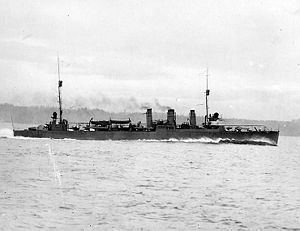Name USS Gwin (DD-69) Decommissioned 28 June 1922 Fate Scrapped Length 96 m | Commissioned 18 March 1920 Struck 25 January 1936 Launched 25 December 1917 Draft 2.69 m | |
 | ||
Builder Seattle Construction and Drydock Company | ||
USS Gwin (DD-71)was one of six Caldwell-class destroyers built for the United States Navy in the 1910s.
Contents
Description
The Caldwells were a transitional design between the "thousand-tonners" of the Sampson-class and the mass-produced destroyers built during World War I. They introduced the flush-deck and were known as the first of the "flush deckers" that were so wet in heavy weather. The ship displaced 1,262 long tons (1,282 t) at standard load and 1,379 long tons (1,401 t) at deep load. They had an overall length of 315 feet 6 inches (96.2 m), a beam of 30 feet 7 inches (9.3 m) and a draught of 8 feet 10 inches (2.7 m). They had a crew of 5 officers and 95 enlisted men.
The propulsion arrangements differed between the ships of the class. Gwin was powered by two Parsons steam turbines, each driving one propeller shaft, using steam provided by four Thornycroft boilers. The turbines developed a total of 18,500 shaft horsepower (13,800 kW) and were designed to reach a speed of 30 knots (56 km/h; 35 mph). The ships carried a maximum of 205 long tons (208 t) of fuel oil that gave them a range of 2,500 nautical miles (4,600 km; 2,900 mi) at 20 knots (37 km/h; 23 mph).
The ships were armed with four 4-inch (102 mm) guns in single mounts and were fitted with two 1-pdr (28 mm) guns for anti-aircraft defense. Their primary weapon, though, was their torpedo battery of a dozen 21-inch (530 mm) torpedo tubes in four triple mounts. During World War I, the 1-pounders were replaced by 3-inch (76 mm) anti-aircraft (AA) guns and a "Y-gun" depth charge thrower replaced the aft AA gun and the searchlight.
Construction and career
Gwin, the second Navy ship named for Lieutenant Commander William Gwin, was launched 22 December 1917 by the Seattle Construction & Drydock Company, Seattle, Washington, sponsored by Mrs. James S. Woods; and commissioned at Puget Sound 18 March 1920, Lieutenant Commander H. H. Bousen in command. Gwin departed Puget Sound 26 April for calls at California ports, thence through the Panama Canal for Newport, Rhode Island, arriving 2 June. She participated in operations along the eastern seaboard as far south as Charleston, South Carolina.
Gwin was decommissioned in the Philadelphia Navy Yard 28 June 1922. She remained inactive at Philadelphia until her name was struck from the Navy List 25 January 1937. Her hulk was sold for scrapping 16 March 1939 to the Union Shipbuilding Company, Baltimore, Maryland.
